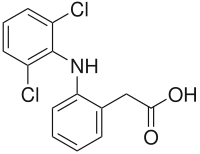
Photo from wikipedia
BackgroundAdvanced glycation end-products play a role in diabetic vascular complications. Their optical properties allow to estimate their accumulation in tissues by measuring the skin autofluorescence (SAF). We searched for an… Click to show full abstract
BackgroundAdvanced glycation end-products play a role in diabetic vascular complications. Their optical properties allow to estimate their accumulation in tissues by measuring the skin autofluorescence (SAF). We searched for an association between SAF and major adverse cardiovascular events (MACE) incidence in subjects with Type 1 Diabetes (T1D) during a 7 year follow-up.MethodsDuring year 2009, 232 subjects with T1D were included. SAF measurement, clinical [age, sex, body mass index (BMI), comorbidities] and biological data (HbA1C, blood lipids, renal parameters) were recorded. MACE (myocardial infarction, stroke, lower extremity amputation or a revascularization procedure) were registered at visits in the center or by phone call to general practitioners until 2016.ResultsThe participants were mainly men (59.5%), 51.5 ± 16.7 years old, with BMI 25.0 ± 4.1 kg/m2, diabetes duration 21.5 ± 13.6 years, HbA1C 7.6 ± 1.1%. LDL cholesterol was 1.04 ± 0.29 g/L, estimated Glomerular Filtration Rates (CKD-EPI): 86.3 ± 26.6 ml/min/1.73 m2. Among these subjects, 25.1% were smokers, 45.3% had arterial hypertension, 15.9% had elevated AER (≥ 30 mg/24 h), and 9.9% subjects had a history of previous MACE. From 2009 to 2016, 22 patients had at least one new MACE: 6 myocardial infarctions, 1 lower limb amputation, 15 revascularization procedures. Their SAF was 2.63 ± 0.73 arbitrary units (AU) vs 2.08 ± 0.54 for other patients (p = 0.002). Using Cox-model, after adjustment for age (as the scale time), sex, diabetes duration, BMI, hypertension, smoking status, albumin excretion rates, statin treatment and a previous history of MACE, higher baseline levels of SAF were significantly associated with an increased risk of MACE during follow-up (HR = 4.13 [1.30–13.07]; p = 0.02 for 1 AU of SAF) and Kaplan–Meier curve follow-up showed significantly more frequent MACE in group with SAF upper the median (p = 0.001).ConclusionA high SAF predicts MACE in patients with T1D.
Journal Title: Cardiovascular Diabetology
Year Published: 2018
Link to full text (if available)
Share on Social Media: Sign Up to like & get
recommendations!